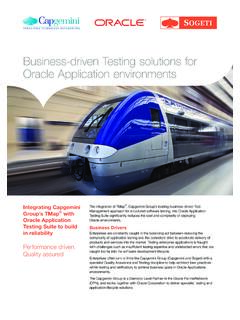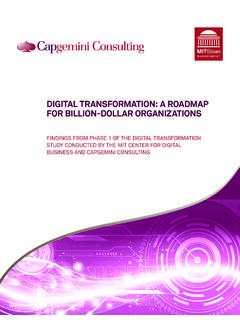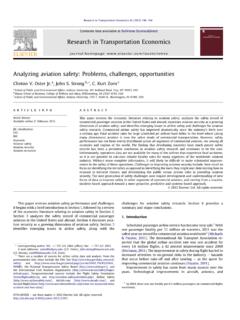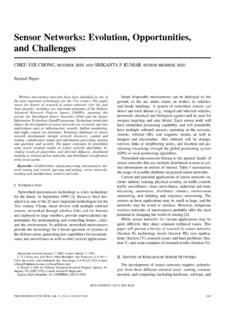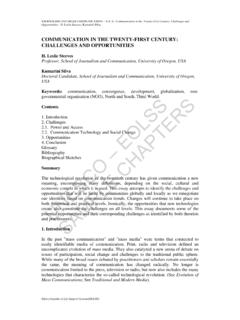Transcription of Long Term Evolution - Capgemini
1 Telecom, Media & Entertainmentthe way we see it9 long Term EvolutionLong Term EvolutionLTE opportunities and challenges for TelcosTelecom & Media InsightsIssue 5810 Contents1 Abstract 12 The Need for LTE 23 Technology Options for Operators 5 FDD LTE 6 TDD LTE (TD-LTE) 64 challenges in LTE Implementation 8 Technical challenges 8 Regulatory Challenge 9 Ecosystem Related challenges 10 Return on Investment (ROI) 115 Next Steps for Telcos 12 Customer Proposition 12 Rollout Strategy 13 Cost Savings 13 Spectrum Policy 14 Telecom, Media & Entertainmentthe way we see it1 long Term EvolutionThe mobile networks of most operators are witnessing an unprecedented rise in data traffic, due to an increasing consumer demand to access bandwidth intensive content on-the-go and the proliferation of a large number of mobile devices such as smartphones and tablets.
2 This trend is exerting extremely high pressure on the capacity constrained network of operators. Faced with this challenge, wireless providers need to upgrade their network infrastructure in order to keep up with data traffic volumes and deliver bits more cost-effectively. When compared to some other upgrade options such as HSPA1, HSPA+, and WiMAX2, long Term Evolution (LTE) provides operators with a technically superior and cost effective solution to deliver true mobile broadband experience. Although LTE standards and the ecosystem have not yet evolved fully and an upgrade requires significant capital investment, operators can still reap tremendous benefit by formulating the right migration strategy. A focus on key priorities such as pricing, rollout strategy, network sharing, and spectrum policy will be instrumental in the successful rollout of LTE.
3 Having realized its potential, several operators across the globe have already deployed LTE commercially and many more are in the Abstract1 High Speed Packet Access is the amalgamation of two mobile telephony protocols, High Speed Downlink Packet Access (HSDPA) and High Speed Uplink Packet Access (HSUPA).2 Worldwide Interoperability for Microwave increasing proliferation of a range of Internet enabled mobile devices, such as tablets, smart-phones, and e-readers has added to the rising consumer need to access rich content on the go. This phenomenon has resulted in the explosion of mobile data traffic exerting an unprecedented demand on the network of wireless operators (see Figure 1). Driving this boom will be the increasing consumption of mobile video, which will consume nearly 66% of all mobile data traffic by 20143.
4 Bandwidth intensive applications, especially those based on video, expose the capacity bottlenecks and the gap which customers are increasingly facing between peak rates in perfect conditions and real everyday experiences. It is, therefore, imperative for operators to ensure that the average user s mobile experience is not compromised especially in high traffic areas. In order to enhance subscriber experience, prepare access networks for the onslaught of data intense applications, and reduce operational expenditure, operators will need to upgrade their networks sooner or later. For doing so, they have multiple technology options such as WCDMA5, HSPA, HSPA+, CDMA2000 EV-DO6, WiMAX and LTE to choose from. The migration strategy of each operator is likely to be different and will be based on several factors such as the existing state of their networks, current and projected data demand, costs considerations, and spectrum availability.
5 In Japan, while NTT DoCoMo is skipping HSPA+ and migrating straight to LTE, SoftBank Mobile believes there are still significant opportunities with 42 Mbps HSPA+ , given the various migration options, LTE seems to offer the most efficient, cost effective (in terms of TCO8 and OPEX9 savings), and future proof solution for operators, who can reap considerable long term benefits by leveraging an early mover advantage. 3 Cisco Visual Networking Index, Global Mobile Data Traffic Forecast Update, One Exabyte is equal to 1 billion Wideband Code Division Multiple Evolution Data , HSPA v LTE: the debate continues, May Total Cost of Operating The Need for LTE CAGR 108% 2009 2010 2011 2012 2013 2014 Source: Cisco Visual Networking Index: Global Mobile Data Forecast Update, 2009-2014 Figure 1.
6 Global Mobile Data Traffic, Exabytes4 per Month, 2009-2014 The explosion of mobile data traffic is exerting unprecedented demand on networks Video will represent nearly 66% of all mobile data traffic by 2014 Telecom, Media & Entertainmentthe way we see it3 long Term EvolutionLTE is a pure packet switched Evolution of UMTS10 3G technology which offers significant advantages such as higher spectral efficiency, lower cost of transmission per megabyte, higher throughput, and lower latency when compared to existing wireless network technologies (see Figure 2). It is also backward compatible with the CDMA14 family of technologies and thereby enables even CDMA operators to move to this technology. Furthermore, by deploying LTE SON15 telcos can significantly improve operational efficiency and reduce OPEX. Thus, LTE offers the best potential to address one of the most significant priorities of wireless operators, which is, upgrading their capacity constrained networks.
7 Having realized the potential, telcos across the globe have already taken the first steps towards the deployment of LTE networks (see Figure 3). In December 2009, by launching services in Sweden and Norway, TeliaSonera became the first operator in the world to offer LTE. In September 2010, Metro PCS, a prepaid service provider in the US, became the second operator to launch LTE services. It offers its service on the first commercially available 4G enabled handset in the 10 Universal Mobile Telecommunications Multiple Input Multiple Output: MIMO uses multiple antennas at both the transmitter and receiver to improve communication Quadrature Amplitude 3 GPP TR Code Division Multiple The Next Generation Mobile Networks (NGMN) Alliance and the Third Generation Partnership Project (3 GPP) have standardized a set of capabilities known as Self-Organizing Networks (SON).
8 With SON operators can automate previously manual steps throughout the lifecycle of a network from planning and deployment to optimization and : Capgemini TME Strategy Lab Analysis; Motorola Whitepaper, Upgrade Strategies for Mass Market Mobile Broadband, 2009; 3G Americas, HSPA to LTE Advanced, September 2009; Morgan Stanley ResearchUMTS / HSPA LTE WiMAX HSDPA HSPA+ 2X2 MIMO(11) HSPA+ SIC, 64 QAM(12) LTE 2X2 MIMO LTE 4X2 MIMO LTE 4X4 MIMO Rel 2X2 MIMO Rel 4X2 MIMO UMTS Release Antenna Technology Downlink Speed (Mbps) Uplink Speed (Mbps) Type Qty 5 MHz 10 MHz 20 MHz R6 HSPA SIMO 1x1, 1x2 R7 HSPA+ 64-QAM SIMO 1x1, 1x2 R7 HSPA+ MIMO 2x2 R8 LTE MIMO 2x2 43 86 173(13)58 R8 LTE MIMO 4x4 82 163 326(13)86 Downlink Spectral Efficiency (bits per second/Hz/sector) Downlink and Uplink Peak Throughput (Mbps) Relative Cost per bit of Transmitted Data 0 20 40 60 80 100 3G HSPA HSPA + LTE 0 40 80 120 160 200 3G HSPA HSPA + LTE - 70% -20% -50% Latency (ms) Figure 2.
9 Comparison of LTE Peak Theoretical Throughput, Latency, Spectral Efficiency and Relative Cost per Bit Parameters with Other Mobile Network Technologies416 Company Press Release. 17 Infonetics Research, LTE Infrastructure Forecasts Up, Along With Operator Commitments to LTE Networks, November , the Samsung Craft16. While TeliaSonera, which is a GSM operator, offers its LTE services over USB dongles, Metro PCS, a CDMA2000 player, provides unlimited and contract less LTE services over a handset. It is noteworthy how LTE can be delivered by both large and small operators, irrespective of their existing wireless technology, over multiple over 100 commitments by service providers around the world to deploy LTE networks, the worldwide LTE infrastructure market is set to grow tenfold to reach US$ billion17. Going by the trends, LTE seems to be the technology of choice for most operators across the world.
10 In this paper, we evaluate the technology options within LTE, the most significant barriers regarding its uptake, and recommend the best approach for different , Media & Entertainmentthe way we see it5 long Term EvolutionThe technical advantages of LTE which render significant benefits over other wireless technologies can be attributed to its superior access and antenna technologies. The use of technologies such as OFDM18, SC-FDMA19, MIMO, and multiple channel bandwidths results in attributes such as high throughput, low power consumption, high spectral efficiency, and improved coverage and cell performance. LTE can be deployed in both paired spectrum for Frequency Division Duplex (FDD) and unpaired spectrum for Time Division Duplex (TDD), and we witness a greater adoption of FDD in initial deployments (see Figure 3). In this section, we will primarily focus on the TDD and FDD technology deployment options for FDD and TDD have their own advantages and disadvantages (see Figure 4), and decisions on which duplex scheme to adopt can be taken depending on the operator s business requirements.

